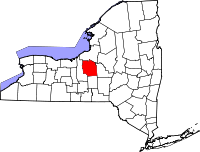Syracuse, New York
| Syracuse | |
|---|---|
| — City — | |
|
|
|
| Nickname(s): Salt City, 'Cuse | |
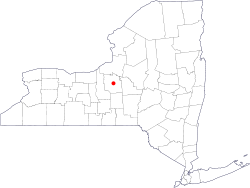 |
|
| Coordinates: | |
| Country | United States |
| State | New York |
| County | Onondaga |
| Incorporated | 1825 (village) |
| Incorporated | 1847 (city) |
| Government | |
| - Type | Mayor-Council |
| - Mayor | Stephanie A. Miner (D) |
| - Common Council |
Members' List
|
| Area | |
| - City | 26.6 sq mi (66.4 km2) |
| - Land | 26 sq mi (65 km2) |
| - Water | 0.6 sq mi (1.4 km2) 2.15% |
| Elevation | 380 ft (116 m) |
| Population (2006) | |
| - City | 140,658 |
| - Density | 5,871/sq mi (2,266.8/km2) |
| - Urban | 402,267 |
| - Metro | 732,117 |
| Time zone | Eastern (UTC-5) |
| - Summer (DST) | Eastern Daylight Time (UTC-4) |
| Area code(s) | 315 |
| Twin Cities | |
| - Chiayi City | |
| - Tampere | |
| FIPS code | 36-73000 |
| GNIS feature ID | 0966966 |
| Website | www.syracuse.ny.us |
Syracuse (locally pronounced /ˈsɛrəkjuːs/ or /ˈsɪrəkjuːs/; generally the latter by non-natives) is a city in and the county seat of Onondaga County, New York, United States,[1] and the fifth most populous city in the state[2]. At the 2000 census, the city population was 147,306, and its metropolitan area had a population of 732,117. It is the economic and educational hub of Central New York, a region with over a million inhabitants. Syracuse is also well-provided with convention sites, with a downtown convention complex and, directly west of the city, the Empire Expo Center, which hosts the annual Great New York State Fair. Syracuse was named after the original Syracuse, (Siracusa in Italian) a city on the eastern coast of the Italian island of Sicily.
The city has functioned as a major crossroads over the last two centuries, first between the Erie Canal and its branch canals, then of the railway network. Today, Syracuse is located at the intersection of Interstates 81 and 90, and its airport is the largest in the region. Syracuse is home to Syracuse University, a major research university, as well as several smaller colleges and professional schools. In 2010 Forbes rated Syracuse 4th in the top 10 places to raise a family.[3]
History
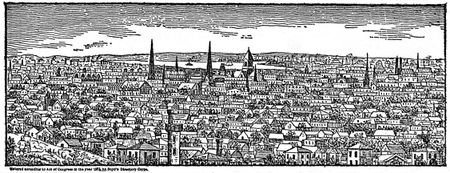
The Syracuse area was first seen by Europeans when French missionaries came to the area in the 1600s. At the invitation of the Onondaga Nation, one of the five constituent members of the Iroquois confederacy, a group of Jesuit priests, soldiers, and coureurs des bois (including Pierre Esprit Radisson) set up a mission, known as Saint Marie Among the Iroquois, or Ste. Marie de Gannent aha, on the northeast shore of Onondaga Lake.
The mission was short lived, as the Mohawk Nation hinted to the Onondaga that they should sever their ties with the French, or the Onondaga's guests would suffer a horrible fate. When the men in the mission caught wind of this, they left under cover of a cold night in March. Their stay had been less than two years. The remains of the mission have been located underneath a restaurant in nearby Liverpool. There is now a living history museum in Liverpool that recreates the mission.
Early settlers
Just after the Revolutionary War, more settlers came to the area, mostly to trade with the Onondaga Nation. Ephraim Webster left the Continental Army to settle in 1784, along with Asa Danforth, another Revolutionary War hero. Comfort Tyler, whose engineering skill contributed to regional development, arrived four years later. All three settled in Onondaga Hollow south of the present city center, which was then marshy.
Jesuit missionaries visiting the Syracuse region in the mid 1600s reported salty brine springs around the southern end of "Salt Lake," known today as Onondaga Lake.
Original settlement
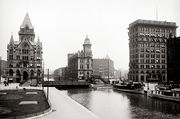
The original settlement went through several name changes until 1824, first being called Salt Point (1780), then Webster's Landing (1786), Bogardus Corners (1796), Milan (1809), South Salina (1812), Cossits’ Corners (1814), and Corinth (1817). The U.S. Postal Service rejected the name Corinth upon its application for a post office, stating there was already a post office by this name in New York.
Because of similarities such as a salt industry and a neighboring village named Salina, the name Syracuse was chosen by village planner, John Wilkinson,[4] after Syracuse, Sicily. In 1825, the Village of Syracuse was officially incorporated.
Erie Canal
Five years later, in 1830, the Erie Canal, which ran through the village, was completed. The Village of Syracuse and the Village of Salina were combined into the City of Syracuse on December 14, 1847. Harvey Baldwin was the first mayor of the new city.[5]
Salt industry
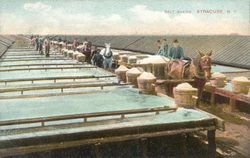
After the discovery of salty brines in Onondaga Lake by the Jesuit missionaries in the mid-1650s, the 1788 Treaty of Fort Stanwix, and the subsequent designation of the area by the state of New York as the Onondaga Salt Springs Reservation[6] provided the basis for commercial salt production from the late 1700s through the early 1900s; brine from wells that tapped into halite(common salt) beds in the Salina shale near Tully, New York, 15 miles south of the city were developed in the 19th century. It is the north flowing brine from Tully that is the source of salt for the "salty springs" found along the shoreline of Onondaga lake.
The rapid development of this industry in the 18th and 19th centuries led to the nicknaming of Syracuse as "The Salt City."[7]

The opening of the Erie Canal caused a steep increase in the sale of salt, not simply because of the improved and lower cost of transportation, but because the canal led New York farms to change from wheat to pork, and curing pork required salt.
Until 1900 the bulk of the salt used in the United States came from Syracuse[8] As salt production climbed, the processing became increasingly mechanized, and local industry became more generalized; population grew from 250 in 1820, to 5,000 in 1850, making it the twelfth largest city in the Union at that time.
Industrial growth

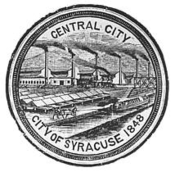
The salt industry declined after the Civil War, but a new manufacturing industry arose in its place. Manufacturing proliferated in Syracuse, New York from the late 1870s through the early 1900s, a period known as the Industrial Revolution. Franklin Chase, author of the 1924 history "Syracuse and Its Environs," summed up the early 20th century in Syracuse with this claim: "In truth, Syracuse manufactured more different articles numerically than even New York City itself."[9]
During the early years, numerous businesses and stores were established, including the Franklin Automobile Company, which produced automobiles with air-cooled engines. In 1902, the Franklin (automobile) Model A attained the distinction of being the first four-cylinder automobile produced in the United States.[10]
Other important industries included the Century Motor Vehicle Company, manufacturer of steam powered automobiles; and the Craftsman Workshops, the center of Gustav Stickley's handmade furniture empire.
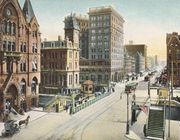
The first Solvay Process Company plant in the United States, was erected on the southeastern shore of Onondaga lake in 1884 and the village was given the name Solvay, New York to commemorate its inventor, Ernest Solvay. In 1861, he developed the ammonia-soda process for the manufacture of soda ash {anhydrous sodium carbonate, a rare chemical called natrite, to distinguish it from natural natron of antiquity} from brine wells dug in the southern end of Tully valley (as a source of sodium chloride) and limestone (as a source of calcium carbonate). The process was an improvement over the earlier Leblanc process. The Syracuse Solvay plant was the incubator for a large chemical industry complex owned by Allied Signal in Syracuse, the result of which made Onondaga Lake the most polluted in the nation.
Since the discovery of large deposits of natural sodium carbonateTrona in 1938, near Green River in Wyoming, the Solvay process became uneconomical and the Syracuse Solvay Process Company plant closed permanently in 1985. No such plants operate now in North America. However, throughout the rest of the world the Solvay process remains the major source of soda ash.
The closing of the Onondaga Salt Springs Reservation in the early 1900s and the end to mining brine in the southern part of the Tully valley in the late 1900s closed the final chapter of salt mining in the Syracuse region, but groundwater flowing along the southeastern shore of Onondaga lake in Syracuse still allows salty water from a thousand feet below the southern Tully valley to flow by gravity feeding salt springs around the lake where the Salina shale contains no halite beds.[7]
Abolitionism and the Underground Railroad in Syracuse
Syracuse became an active center for the abolitionist movement, due in large part to the influence of Gerrit Smith and a group allied with him, mostly associated with the Unitarian Church and their pastor The Reverend Samuel May in Syracuse, as well as with Quakers in nearby Skaneateles, supported as well by abolitionists in many other religious congregations.[11] Prior to the Civil War, due to the work of Jermain Wesley Loguen and others in defiance of federal law, Syracuse was known as the "great central depot on the Underground Railroad". On October 1, 1851, William Henry, a freed slave known as "Jerry" was arrested under the Fugitive Slave Law. The anti-slavery Liberty Party was holding its state convention in the city, and when word of the arrest spread, several hundred abolitionists including Charles Augustus Wheaton broke into the city jail and freed Jerry. The event came to be widely known as the "Jerry Rescue". In the aftermath, the Congregationalist minister Samuel Ringgold Ward had to flee to Canada to escape persecution because of his participation.[11]
Syracuse university chartered
Syracuse University was chartered in 1870 as a Methodist-Episcopal institution.
Geneva Medical College was founded in 1834 in Geneva, New York. It is now known as Upstate Medical University, the most prestigious medical college in the Syracuse area, one of only four in the State University of New York system, and one of only five medical schools in the state north of New York City.
Twentieth century
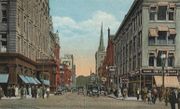
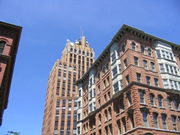

By the twentieth century, Syracuse University was no longer sectarian and had grown from a few classrooms located in downtown Syracuse into a major research institution. It is nationally recognized for its college basketball, college football, and college lacrosse teams. In 1911, under the leadership of Syracuse University trustee, Louis Marshall, the New York State College of Forestry was reestablished in close association with Syracuse University; it since has evolved into the SUNY-ESF. Le Moyne College was founded in 1946; Onondaga Community College in 1962.
World War II sparked significant industrial expansion in the area: specialty steel, fasteners, custom machining. After the war, two of the Big Three automobile manufacturers (General Motors & Chrysler) had major operations in the area. Syracuse was headquarters for Carrier Corporation, Crouse-Hinds traffic signal manufacturing, and General Electric had its main television manufacturing plant at Electronics Parkway in Syracuse.
Mid century
Syracuse's population peaked at 221,000 in 1950. Immigration from abroad introduced many ethnic groups to the city, particularly German, Jewish, Irish, Italian, and Polish. African Americans had lived in Syracuse since Revolutionary War days, but between 1940 and 1960, some of the three million African Americans who migrated from the south to northern cities also settled in Syracuse. In the 1980s, many immigrants from Africa and Central America also moved to Syracuse, as they did to many northern cities — sometimes under the auspices of several religious charities. However, these new Syracusans could not make up for the flow of residents out of Syracuse, either to its suburbs or out of state, due to job loss. The city's population slowly decreases every year.
Much of the city fabric changed after World War II, although Pioneer Homes, one of the earliest government housing projects in the US, had been completed earlier, in 1941. Many of Syracuse's landmark buildings were demolished in the 1950s and 1960s. The federal Urban Renewal program cleared large sectors that remained undeveloped for many decades, although several new museums and government buildings were built.
The manufacturing industry in Syracuse began to falter in the 1970s. Many small businesses failed during this time, which contributed to an already increasing unemployment rate. Rockwell International moved their factory outside New York state. General Electric moved its television manufacturing operations to Suffolk, Virginia and later to Singapore. The Carrier Corporation moved its headquarters out of Syracuse and outsourced manufacturing to Asian locations. Nevertheless, although city population has declined since 1950, the Syracuse metropolitan area population has remained fairly stable, even growing by 2.5 percent since 1970. While this growth rate is greater than much of Upstate New York, it is far below the national average during that period.
Geography and climate
Geography
Syracuse is located at (43.046899, -76.144423).[12]
According to the United States Census Bureau, the city has a total area of 25.6 square miles (66 km2), of which, 25.1 square miles (65 km2) of it is land and 0.6 square miles (1.6 km2) of it (2.15%) is water.
The city stands at the northeast corner of the Finger Lakes Region. The city has many neighborhoods which were originally various villages that joined the city over the years. Although the central part of Syracuse is flat, many of its neighborhoods are located on small hills such as University Hill and Tipperary Hill. Land to the north of Syracuse is generally flat while land to the south is hilly.
About 27 percent of Syracuse's land area is covered by 890,000 trees — a higher percentage than in Albany, Rochester or Buffalo. This is despite the Labor Day Storm of 1998, a derecho which destroyed approximately 30,000 trees. The sugar maple accounts for 14.2 percent of Syracuse's trees, followed by the Northern white cedar (9.8 percent) and the European buckthorn (6.8 percent).
The most common street tree is the Norway maple (24.3 percent) followed by the honey locust (9.3 percent). The densest tree cover in Syracuse is in the two Valley neighborhoods, with 46.6 percent of their land covered by trees. The lowest tree cover percentage is found downtown, which consists of only 4.6 percent trees.[13]
Syracuse's main water source is Skaneateles Lake, one of the country's cleanest lakes, located 15 miles (24 km) southwest of the city. Water from nearby Onondaga Lake is not drinkable due to industrial dumping that spanned many decades, leaving the lake heavily polluted.[14] Incoming water is left unfiltered, and chlorine is added to prevent bacterial growth. For periods of drought, there is also a backup line which uses water from Lake Ontario.[15]
Onondaga Creek, a waterway that runs through downtown, flows northward through the city. There are plans and aspirations to create a creek walk that will connect the Lakefront and Inner Harbor to Franklin Square, Armory Square, The Valley, and ultimately the Onondaga Nation. The creek is navigable, yet can be quite a challenge as its channelized nature speeds up its flow, particularly in the spring, when it may be dangerous. Drownings of youngsters resulted in fencing of the creek through some residential areas.
Climate
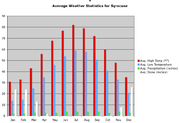
Syracuse has a humid continental climate and is known for its snowfall. Boasting 115.6 inches (294 cm) on average,[16] the Syracuse metro area receives more snow on average than any other large city in the United States.[17][18] Syracuse continually wins the Golden Snowball Award, among Upstate cities. Its record so far is 192.1 inches (488 cm). The high snowfall is a result of the fact that the city receives both lake effect from nearby Lake Ontario and nor'easter snow. Snow most often falls in small (about 1–3 inches/2.5–7.6 centimetres), almost daily doses, over a period of several days. Larger snowfalls do occur occasionally, and even more so in the northern suburbs.
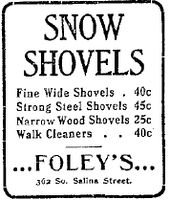
One notable blizzard was the Blizzard of 1993, during which 42.9 inches (109 cm) fell on the city within 48 hours, with 35.6 inches (90 cm) falling within the first 24 hours. Syracuse received more snow than any other city in the country during this storm, which shattered a total of eight local records, including the most snow in a single snowstorm.[19]
A second notable snowfall was the Blizzard of 1966, with 42.3 inches (107 cm). The Blizzard of '58 occurred in February (16-17th) across Oswego and Onondaga counties. This storm was an actual blizzard due to the high winds, blowing snow and cold. 26.1 inches (66 cm) of snow was measured at Syracuse N.Y. and drifts reached 20 feet (600 cm) in Oswego County. (See Thirtieth Publication of the Oswego County Historical Society, (1969) and The Climate and Snow Climatology of Oswego N.Y., (1971)

February, 1958 was the snowiest month ever in Syracuse, with a record 72.6 inches (184 cm) recorded in 28 days. Syracuse shivered under a white blanket that averaged 4 feet (120 cm) on February 19. Syracuse declared a snow emergency under a new law that allowed municipalities to demand that streets be cleared of vehicles to help with plowing operations.[20]
Syracuse's hottest month is historically July, with an average high temperature of 82 °F (28 °C), while its coldest month is historically January, with an average high temperature of 31 °F (−1 °C). The Record high of 102 °F (39 °C) was recorded on July 9, 1936 and record low of −26 °F (−32 °C) has been witnessed three times since 1922, the last being February 18, 1979.[21].
While the average high during summer is around the low 80's, when adding humidity, the apparent temperature highs extend upward in the range of mid-80's to mid-90's in the city. Days just shy of 100 °F (38 °C), such as 96 or 97 °F (36 °C), are not uncommon in and around the city with the humidity factored in. However, days above 100 °F (38 °C) are more rare, even with humidity taken into account.
A few recent summers in Syracuse have been warmer than previous ones in the city and, like in some other places in the nation, previous records have been broken. For example, the summers of 2005 and 2002 were, respectively, the hottest and second-hottest summers on record.[22]
| Climate data for Syracuse, New York (Syracuse Airport, 1971-2000) | |||||||||||||
|---|---|---|---|---|---|---|---|---|---|---|---|---|---|
| Month | Jan | Feb | Mar | Apr | May | Jun | Jul | Aug | Sep | Oct | Nov | Dec | Year |
| Record high °F (°C) | 70 (21.1) |
69 (20.6) |
87 (30.6) |
92 (33.3) |
96 (35.6) |
100 (37.8) |
102 (38.9) |
100 (37.8) |
97 (36.1) |
87 (30.6) |
81 (27.2) |
72 (22.2) |
102 (38.9) |
| Average high °F (°C) | 31.4 (-0.33) |
33.5 (0.83) |
43.1 (6.17) |
55.7 (13.17) |
68.5 (20.28) |
77 (25) |
81.7 (27.61) |
79.6 (26.44) |
71.4 (21.89) |
59.8 (15.44) |
47.4 (8.56) |
36.3 (2.39) |
57.1 (13.94) |
| Average low °F (°C) | 14 (-10) |
15.5 (-9.17) |
24.2 (-4.33) |
34.9 (1.61) |
45.8 (7.67) |
54.6 (12.56) |
60.1 (15.61) |
58.8 (14.89) |
51.1 (10.61) |
40.4 (4.67) |
32 (0) |
20.9 (-6.17) |
37.7 (3.17) |
| Record low °F (°C) | -26 (-32.2) |
-26 (-32.2) |
-16 (-26.7) |
7 (-13.9) |
15 (-9.4) |
34 (1.1) |
44 (6.7) |
40 (4.4) |
25 (-3.9) |
18 (-7.8) |
1 (-17.2) |
-26 (-32.2) |
-26 (-32.2) |
| Precipitation inches (mm) | 2.60 (66) |
2.12 (53.8) |
3.02 (76.7) |
3.39 (86.1) |
3.39 (86.1) |
3.71 (94.2) |
4.02 (102.1) |
3.56 (90.4) |
4.15 (105.4) |
3.20 (81.3) |
3.77 (95.8) |
3.12 (79.2) |
40.05 (1,017.3) |
| Snowfall inches (cm) | 33.6 (85.3) |
24.0 (61) |
18.8 (47.8) |
4.8 (12.2) |
0.1 (0.3) |
0 (0) |
0 (0) |
0 (0) |
0 (0) |
0.5 (1.3) |
11.1 (28.2) |
28.3 (71.9) |
121.2 (307.8) |
| Avg. precipitation days | 19.7 | 15.5 | 16.5 | 14 | 12.7 | 12.2 | 11.3 | 11.1 | 12.6 | 13.2 | 16.8 | 18.3 | 173.9 |
| Avg. snowy days | 17.2 | 13.3 | 9.7 | 3.0 | 0.1 | 0 | 0 | 0 | 0 | 0.7 | 6.3 | 14.0 | 64.3 |
| Sunshine hours | 102.3 | 118.7 | 173.6 | 204 | 241.8 | 261 | 288.3 | 248 | 192 | 145.7 | 78 | 68.2 | 2,121.6 |
| Source #1: NOAA [21] | |||||||||||||
| Source #2: Hong Kong Observatory [23] | |||||||||||||
Demographics
| Historical populations | |||
|---|---|---|---|
| Census | Pop. | %± | |
| 1850 | 22,271 |
|
|
| 1860 | 28,119 | 26.3% | |
| 1870 | 43,051 | 53.1% | |
| 1880 | 51,792 | 20.3% | |
| 1890 | 88,143 | 70.2% | |
| 1900 | 108,374 | 23.0% | |
| 1910 | 137,249 | 26.6% | |
| 1920 | 171,717 | 25.1% | |
| 1930 | 209,326 | 21.9% | |
| 1940 | 205,967 | −1.6% | |
| 1950 | 220,583 | 7.1% | |
| 1960 | 216,038 | −2.1% | |
| 1970 | 197,208 | −8.7% | |
| 1980 | 170,105 | −13.7% | |
| 1990 | 163,860 | −3.7% | |
| 2000 | 147,306 | −10.1% | |
| Est. 2009 | 138,560 | −5.9% | |
| [24][25] | |||
| Syracuse Compared (monetary values in United States dollars) |
|||
|---|---|---|---|
| 2000 Census | Syracuse | NY State | U.S. |
| Total population | 147, 306 | 18,976,457 | 281,421,906 |
| Population, percent change, 1990 to 2000 | -10.4% | +5.5% | +13.1% |
| Population density | 5,871/sq mi | 402/sq mi | 80/sq mi |
| Median household income (1999) | $25,000 | $43,393 | $41,994 |
| Per capita income | $15,168 | $23,389 | $21,587 |
| Bachelor's degree or higher | 23% | 27% | 24% |
| Foreign born | 8% | 20% | 11% |
| White | 64% | 62% | 69% |
| Black | 25% | 16% | 12% |
| Hispanic | 5% | 15% | 13% |
| Asian | 10% | 6% | 4% |
As of the census[26] of 2000, there were 147,306 people, 59,482 households, and 30,335 families residing in the city. The population density was 5,871.0 people per square mile (2,266.8/km²). There were 68,192 housing units at an average density of 2,717.8/sq mi (1,049.4/km²).
The racial makeup of the city was 64.26% White, 25.35% African American, 1.13% Native American, 3.37% Asian, 0.05% Pacific Islander, 2.23% from other races, and 3.61% from two or more races. Hispanic or Latino of any race were 5.27% of the population.
The largest ancestries include Irish (15.9%), Italian (14.1%), German (12.2%), English (7.6%), and Polish (5.0%).[27]
There were 59,482 households out of which 30.46% had children under the age of 18 living with them, 12.65% were married couples living together, 14.84% had a female householder with no husband present, and 48.58% were non-families. 38.2% of all households were made up of individuals and 11.9% had someone living alone who was 65 years of age or older. The average household size was 2.29 and the average family size was 3.11.
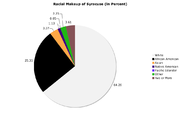
In the city the population was spread out with 25.0% under the age of 18, 16.8% from 18 to 24, 27.9% from 25 to 44, 17.5% from 45 to 64, and 12.9% who were 65 years of age or older. The median age was 30 years. For every 100 females there were 88.9 males. For every 100 females age 18 and over, there were 84.7 males.
The median income for a household in the city was $25,000, and the median income for a family was $33,026. Males had a median income of $30,312 versus $23,997 for females. The per capita income for the city was $15,168. About 21.7% of families and 27.3% of the population were below the poverty line, including 35.1% of those under age 18 and 12.4% of those age 65 or over.
Economy
Syracuse's economy has faced challenges over the past decades as industrial jobs have left the area. The number of local and state government jobs also has been declining for several years. Syracuse's top employers are now primarily in education and the service industry. University Hill is Syracuse's fastest growing neighborhood, fueled by expansions by Syracuse University and Upstate Medical University (a division of the State University of New York), as well as dozens of small medical office complexes.
Top employers
The top employers in the Syracuse region and the size of their workforce, as of January 1, 2008:[28]
- State University of New York Upstate Medical University: 6,400
- Syracuse University: 5,925
- Wegmans Food Markets: 3,760
- St. Joseph's Hospital Health Center: 3,150
- Magna International: 600
- Crouse Hospital: 2,400
- Lockheed Martin Corp.: 2,350
- National Grid USA: 1,860
- Loretto: 1,825

Bristol-Myers Squibb, founded by alums of nearby Hamilton College, has a complex near the Eastwood district.[29] Time Warner Cable has based one of its divisions in Syracuse.[30]
Today the Syracuse area has few extremely large employers, but rather many smaller ones, which provides for a certain amount of stability. Additionally, eight of the area's top eleven employers are in education or the service industry, which tend to be much more stable than the manufacturing industry.
The Syracuse area's unemployment rate of 5.0 percent is comparable to the national rate of 4.8 (March, 2006). Throughout 2006, the area has continued to gain jobs over the previous year's figures. During February and March 2006, the area's job growth rate tied with New York City for the highest in the state.[31]
Tallest buildings
Since 1927 the State Tower Building has been the tallest in Syracuse.
| Name | Height | Floors | Use | Built | |||
|---|---|---|---|---|---|---|---|
| The State Tower Building | 95 m | 23 | Office | 1928 | |||
| AXA Tower I | 82 m | 19 | Commercial office | 1966 | |||
| AXA Tower II | 82 m | 19 | Commercial office | 1973 | |||
| Toomey Abbott Towers | 70 m | 24 | Senior living | 1968 | |||
| Jefferson Tower | 69 m | 23 | Residential | 1967 | Lawrinson Hall | ? m | 21 |
Neighborhoods

The City of Syracuse officially recognizes 26 neighborhoods within its boundaries. Some of these have small additional neighborhoods and districts inside of them. In addition, Syracuse also owns and operates Syracuse Hancock International Airport, located on the territory of four towns north of the city.
Syracuse's neighborhoods reflect the historically divided population. Traditionally, Irish, Polish and Ukrainian Americans settled on its westside; Jewish Americans on its eastside; German and Italian Americans on the northside; and African-Americans on its southside.
Business districts
In addition to the dominant Carousel Center shopping mall in the Syracuse's Lakefront neighborhood, many of the city's more traditional neighborhoods continue to have active business districts:
- Downtown: Armory Square has replaced South Salina Street as the main retail and dining area of Downtown Syracuse. Armory Square has around 30 dining establishments, around 20 pubs, bars and clubs, and over 50 other retail stores. Similarly, but on a smaller scale, there is the Hanover Square area.
- Eastwood: Calling itself "the village within the city", this former village still has a retail corridor along James Street.
- Little Italy: A neighborhood with Italian origins, Little Italy (part of the Near Northeast neighborhood) has several blocks of bakeries, restaurants, pizzerias, shops, and services.
- University Hill: Marshall Street, along with its terminus South Crouse Avenue, is lined with stores, bars, and restaurants, primarily catering to the student population on "The Hill", as well as the over 25,000 people who work there daily. East Genesee Street at the northwestern corner of the neighborhood has several retail establishments, as well.
- Westcott: This neighborhood, located east of University Hill, is inhabited by a wide variety of people, increasingly including some college students as the University grows but still primarily local families and residents. Single-family homes and two-unit apartments comprise the majority of housing. Westcott is known as a bohemian and liberal quarter, and each September hosts the Westcott Street Cultural Fair. The main business district is on Westcott Street between Beech and Dell streets and includes restaurants, bars, an independent bookstore, a consignment shop, and other businesses.
|
|||||
 Eastwood |
 Armory Square |
 Tipperary Hill |
 Strathmore |
|
Clinton Square |
 Hanover Square |
 University Hill |
 Westcott |
 Franklin Square |
 Marshall Street |
 Carousel Mall |
Inner Harbor |
Education
Primary and secondary schools
Public schools
Residents are assigned to schools in the Syracuse City School District.[32]
Colleges and universities
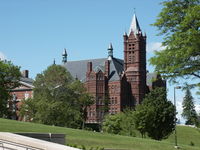
One of Syracuse's major research universities is Syracuse University, located on University Hill. It had an enrollment of 19,084 for the 2006-2007 academic year[33]
Immediately adjacent to Syracuse University are two doctoral-degree granting State University (SUNY) schools, the SUNY College of Environmental Science and Forestry and SUNY Upstate Medical University. Both institutions have long-standing ties to Syracuse University. SUNY Upstate Medical University is also one of Syracuse's major research universities and is one of only about 125 academic medical centers in the country. It is the region's largest employer[34]
Also serving Syracuse are Le Moyne College on the city's eastern border, and Onondaga Community College, which has its main campus in the adjacent Town of Onondaga and has two smaller campuses downtown and in Liverpool. A branch of SUNY's Empire State College is located in downtown Syracuse, along with a campus of the nationwide Bryant & Stratton College. A campus of ITT Technical Institute also calls the Syracuse metropolitan area home, also located in Liverpool. There are also Crouse Hospital School of Nursing and Saint Joseph's School of Nursing
Other colleges and universities in the area include Cornell University and Ithaca College in Ithaca, Hamilton College in Clinton, Oswego State University in Oswego, SUNY Cortland in Cortland, Morrisville State College in Morrisville, Colgate University in Hamilton, Cazenovia College in Cazenovia, Wells College in Aurora, and both Utica College and SUNY Institute of Technology in Utica.
See also
- Education in Syracuse, New York
Public libraries
Onondaga County Public Library operates Syracuse's public libraries.[35]
Arts and culture
.jpg)
An up-to-date directory and events calendar covering all of the visual and performing arts in Syracuse is available at SyracuseArts.net.
Performing arts
Live jazz music is the centerpiece of two annual outdoor festivals in Syracuse, the M&T Syracuse Jazz Festival, Polish Festival as well as the CNY Jazz Arts Foundation's Jazz In The Square Festival. Performers in the last five years have included Chuck Mangione, Joshua Redman, Smokey Robinson, Branford Marsalis, The Bad Plus, Randy Brecker, Stanley Clarke, Jimmy Heath, Terrence Blanchard, Slide Hampton, Bobby Watson, Dr. John, and Aretha Franklin. The Polish Festival hosted Grammy winners Jimmy Sturr and his Orchestra, Polish music legend Stan Borys and Irena Jarocka, Grammy nominee Lenny Goumulka, LynnMarie, Dennis Polisky & The Maestro's Men, Jerry Darlak and the Buffalo Touch & The John Gora Band.
Syracuse is home to the 75-member Syracuse Symphony Orchestra (SSO), founded in 1961. The SSO is under direction of Daniel Hege; its former Music Directors include Frederik Prausnitz and Kazuyoshi Akiyama. The orchestra performs over 200 concerts annually for an audience of over 250,000.
The Clinton String Quartet has been active for over 15 years and is based in the Syracuse area. All four members are also members of the Syracuse Symphony Orchestra.
The Syracuse Friends of Chamber Music for more than a half century have presented a series of concerts by various chamber ensembles.
The Society for New Music, founded in 1982, is the oldest new music organization in the state outside of New York City, and the only year-round new music group in upstate New York. The Society commissions at least one new work each year from a regional composer, awards the annual Brian Israel Prize to a promising composer under 30 years of age, and produces the weekly "Fresh Ink" radio broadcast for WCNY-FM.
The Syracuse Opera Company is a professional company that generally performs three operas each season. It was founded in 1963 as the Opera Chorus of the Syracuse Symphony Orchestra and became independent in 1973. In addition to full performances, it offers several free outdoor concerts each year in Armory Square, Thornden Park, and elsewhere. The company has an annual budget of $1 million and is the only professional opera company in upstate New York.
The Syracuse Shakespeare Festival is a charitable, educational, not-for-profit corporation dedicated to performing the works of William Shakespeare. It was founded in 2002 and is best known for its annual free Shakespeare-in-the-Park program at the Thornden Park Amphitheatre that has attracted more than 12,000 people since its inception.
Syracuse Stage presents experimental and creative theater; a number of its productions have been world premieres and have moved to Broadway. The venue was designed by its most famous former artistic director Arthur Storch. Its current artistic director is Timothy Bond.
The Red House Arts Center is one of Syracuse's newest cultural venues. Opened in 2004, Redhouse is a small theatre housed in a converted hotel, that offers performances by local, national, and international artists, and hosts regular exhibits in its art gallery, and screenings of independent films.
Syracuse is also known for a large contemporary music scene, particularly in the heavy metal, Hardcore, Ska, and Punk rock genres.
Museums and art galleries
- Everson Museum of Art, which opened in 1968 in a building designed by I.M. Pei, features one of the most extensive pottery collections in the United States along with works of American art, dating from the 18th century to the present. This collection includes paintings, sculptures, drawings, photography, and video.
- Erie Canal Museum is a museum dedicated to preserving the history of the Erie Canal and its role in Syracuse's growth.
- International Mask and Puppet Museum is a museum in Little Italy focusing on masks and puppets, the later of which are also used in educational performances for children.
- Milton J. Rubenstein Museum of Science and Technology is a museum located in the Armory Square neighborhood that features exhibits in science and technology and also houses the city's only IMAX theater.
- Onondaga Historical Association Museum & Research Center, located at 321 Montgomery Street downtown, features exhibits on the past of the Syracuse region, and contains historical archives relating to the area's history. Its exhibits include a presentation of the history of the Underground Railroad.
- The Warehouse Gallery is located at 350 West Fayette Street in The Warehouse. It is a part of the Coalition of Museum And Art Centers (CMAC). This new contemporary art center exhibits, commissions, and promotes work by emerging and accomplished artists in a variety of media. The programming attempts to engage the community in a dialogue regarding the role the arts can play in illuminating the critical issues of our times.
- Spark Contemporary Art Space is located at 1005 E. Fayette St. in the Downtown area. Spark is run by Syracuse University graduate art students, but is a venue for a diversity of non-university affiliated events. The gallery's directors curate and organize art and music related events, while local artists can rent the space to hold their own events. With the initiation of a monthly video screening series in 2001, Spark became one of the leading venues for video art in Syracuse. Spark Video provides the community an opportunity to see video work from local and international artists.
- Delavan Art Gallery is located at 501 West Fayette Street in an old farm equipment factory. It has a 3,800 square feet (350 m2) of exhibit space, and, on several other floors in the building, houses the studios of a number of area artists. It has shows which usually open on the first Thursday of the month. It showcases a wide variety of work, from multi-media sculpture to hyperealism.
- Point of Contact Gallery is located at 914 East Genesee Street. The newest member of the Coalition of Museums and Art Centers at Syracuse University, it is a space dedicated to the exploration of the verbal and visual arts and home of the Point of Contact Art Collection. It is a cross-disciplinary open forum for the essential discussion of contemporary art. A showcase for contemporary artists from around the world, with a strong prevalence from Latin America. The Point of Contact collection comprises over 200 original pieces created especially for "Point of Contact", the book series, since 1975. Photography, collage, drawings, paintings and three-dimensional works form this rare collection.
Recreation
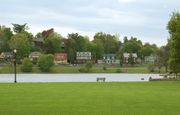
The City of Syracuse maintains over 170 parks, fields, and recreation areas, totaling over 1,000 acres (4.0 km2).[36] Burnet Park includes the first public golf course in the United States (1901) and Rosamond Gifford Zoo. Other major parks include Thornden Park, Schiller Park, Sunnycrest Park, and the joined Onondaga and Kirk Parks. There are 12 public pools, two public ice rinks, and two public nine-hole golf courses in the city.
Right outside the city proper, along the east side and north end of Onondaga Lake, is Onondaga Lake Park. The adjacent Onondaga Lake Parkway is closed to vehicular traffic several hours on Sundays during the summer months, so it can be used for walking, running, biking, and rollerblading. During the holiday season, the park hosts Lights on the Lake, a two-mile (3 km) drive-through light show.
Transportation
Public transportation
Syracuse is served by the Central New York Regional Transportation Authority, or CNYRTA. The CNYRTA operates bus service in Syracuse and its suburbs, as well as to outlying metropolitan area cities such as Auburn, Fulton, and Oswego.
The Pyramid Companies have also proposed a monorail linking Syracuse University to Hancock International Airport to via downtown ,(Downtown Syracuse) to their proposed Destiny Resort to the William F. Walsh Regional Transportation Center and their proposed Destiny Technology Park. The cost of such a line has been estimated at $750 million.
In 2005, local millionaire Tom McDonald proposed an aerial tramway system, called Salt City Aerial Transit (S.C.A.T.), to link the university to the transportation center. The first segment from Syracuse University to downtown has been estimated to cost $5 million, which McDonald plans to raise himself. Due to the perceived low operating costs, the system could run continuously. As of late 2006, the project remains in the planning stage.[37]
Commute
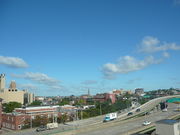
According to the 2000 Census, this is how people aged 16 and over commute to work:
- 65.9% drive alone
- 13.7% carpool
- 10.1% walk
- 6.8% use public buses (CENTRO)
- 0.6% bike
- 0.2% use a taxicab
- 0.013% use elevated rail (OnTrack, now defunct)
Syracuse currently ranks 50th in the United States for high transit ridership and 12th for most pedestrian commuters. 38,332 people commute daily into Onondaga County from the four adjoining counties (2006).[38]
Rail
The city lies on Amtrak's Empire Service, Lake Shore Limited, and Maple Leaf lines.
The Empire Service runs several times daily from Niagara Falls to New York Penn Station, with major stops in Buffalo, Rochester, Syracuse, Utica, and Albany along the way.
The Lake Shore Limited connects Syracuse to the same cities as above (except Niagara Falls), but continues westward from Buffalo to Chicago via Cleveland and Toledo, and eastward to Boston. This train completes one roundtrip daily.
Also completing one roundtrip a day, the Maple Leaf follows the path of the Empire Service train, but continues to Toronto.
Amtrak's station is part of the William F. Walsh Regional Transportation Center.
A regional commuter rail service, OnTrack, was active from 1994 until it was discontinued in 2007 due to low ridership. Its sole route connected the Carousel Center to southern Syracuse, often extending to Jamesville in the summer.
Bus
Greyhound Lines and Trailways provide long-distance bus service. Both also use the William F. Walsh Regional Transportation Center located in the northern area of the city.
Air service
Syracuse is served by the Syracuse Hancock International Airport in nearby Salina, near Mattydale. The airport is served by 17 airlines (9 major), which provide non-stop flights to destinations as far away as Orlando, FL, as well as several daily flights to other important airline hubs and business centers such as Atlanta, Boston, Charlotte, Chicago, Cincinnati, Cleveland, Detroit, New York City, Philadelphia, Pittsburgh, Washington, DC, Toronto,and 147 foreign cites from 87 different countries, not including USA . Six cargo carriers also serve the airport. New York City can be reached in under an hour flight.
Major highways and roads that serve the Syracuse area

Four Interstate Highways run through the Syracuse area:
 Interstate 81 (Highway 401 via Highway 137 in Ontario to Knoxville) runs north-south through Syracuse, and provides access to Canada, Pennsylvania and points south. Its downtown portion is extremely narrow, only consisting of four lanes and essentially no onramps. It forms a physical and psychological border between downtown and University Hill, an issue both Syracuse University and local politicians are trying to address. Moreover, it essentially marks the boundary between two State Senate districts.
Interstate 81 (Highway 401 via Highway 137 in Ontario to Knoxville) runs north-south through Syracuse, and provides access to Canada, Pennsylvania and points south. Its downtown portion is extremely narrow, only consisting of four lanes and essentially no onramps. It forms a physical and psychological border between downtown and University Hill, an issue both Syracuse University and local politicians are trying to address. Moreover, it essentially marks the boundary between two State Senate districts.
 Interstate 90 (Seattle to Boston), also known as the New York State Thruway runs east-west, just north of the city. It is a toll highway that provides access to Rochester, Buffalo, Albany, and the north-south (Interstate 87) part of the Thruway which leads to New York City.
Interstate 90 (Seattle to Boston), also known as the New York State Thruway runs east-west, just north of the city. It is a toll highway that provides access to Rochester, Buffalo, Albany, and the north-south (Interstate 87) part of the Thruway which leads to New York City.
 Interstate 690 runs east-west through the city, and provides access to Interstate 90, as well as to Syracuse's northwestern and eastern suburbs. A spur off I-690 directly west of the city, NY 695, provides freeway access to the southwestern suburbs. It meets Interstate 81 in downtown Syracuse in a highly-complex and incomplete intersection. Most of its routing through the city directly replaced elevated rail lines, a fact quite notable by the city's former main rail terminal, where the freeway spans the width between the terminal and its outermost platform. In 1981 artist Duke Epolito erected sculptures of "passengers" on the far platform. The piece is entitled "Waiting for a Night Train."
Interstate 690 runs east-west through the city, and provides access to Interstate 90, as well as to Syracuse's northwestern and eastern suburbs. A spur off I-690 directly west of the city, NY 695, provides freeway access to the southwestern suburbs. It meets Interstate 81 in downtown Syracuse in a highly-complex and incomplete intersection. Most of its routing through the city directly replaced elevated rail lines, a fact quite notable by the city's former main rail terminal, where the freeway spans the width between the terminal and its outermost platform. In 1981 artist Duke Epolito erected sculptures of "passengers" on the far platform. The piece is entitled "Waiting for a Night Train."
 Interstate 481 forms an eastern loop around the city and continues to the northwest as NY 481 to Fulton and Oswego, on the shore of Lake Ontario.
Interstate 481 forms an eastern loop around the city and continues to the northwest as NY 481 to Fulton and Oswego, on the shore of Lake Ontario.
Two US Highways run through the Syracuse area:
 U.S. Highway 11 (Route 223 in Quebec to New Orleans) passes through Syracuse, including downtown, and it follows the route of Salina and State Streets.
U.S. Highway 11 (Route 223 in Quebec to New Orleans) passes through Syracuse, including downtown, and it follows the route of Salina and State Streets.
 U.S. Highway 20 (Boston to Newport, Oregon) passes south of Syracuse.
U.S. Highway 20 (Boston to Newport, Oregon) passes south of Syracuse.
New York State Route Expressways:
 New York State Route 481 - Travels from NY 104 in Oswego to the junction of Interstate 81 and Interstate 481 north of Syracuse.
New York State Route 481 - Travels from NY 104 in Oswego to the junction of Interstate 81 and Interstate 481 north of Syracuse.
 New York State Route 690 - Was built as an extension of Interstate 690 in the northwest suburbs of Syracuse. The route is a four-lane divided highway from its southern end at I-690, where it meets Interstate 90 (NYS Thruway), to its end northwest of Baldwinsville in Lysander at NY 48 and NY 631.
New York State Route 690 - Was built as an extension of Interstate 690 in the northwest suburbs of Syracuse. The route is a four-lane divided highway from its southern end at I-690, where it meets Interstate 90 (NYS Thruway), to its end northwest of Baldwinsville in Lysander at NY 48 and NY 631.
 New York State Route 695 - Is a short state highway located west of Syracuse in the town of Solvay in Onondaga County. The number of the highway was derived from the two highways that NY 695 links, Interstate 690 and NY 5.
New York State Route 695 - Is a short state highway located west of Syracuse in the town of Solvay in Onondaga County. The number of the highway was derived from the two highways that NY 695 links, Interstate 690 and NY 5.
Government
Executive
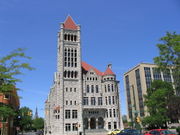
The city is headed by an elected mayor who is limited to two four-year terms. The incumbent is Stephanie Miner elected mayor on November 3, 2009[39][40] The previous mayor was former Syracuse Common Council President Matthew J. Driscoll,[41] who first assumed the position in 2001 after the former mayor, Roy Bernardi, resigned upon his appointment by President George W. Bush to a position in the Department of Housing and Urban Development. After serving the remaining term, Driscoll was re-elected that year, and again in 2005. Driscoll is a member of the Mayors Against Illegal Guns Coalition,[42] a bi-partisan group with a stated goal of "making the public safer by getting illegal guns off the streets." The Coalition is co-chaired by Boston Mayor Thomas Menino and New York City Mayor Michael Bloomberg.
Legislative
The legislative branch of Syracuse is the Syracuse Common Council. It consists of a president and nine members, currently:
|
|
Judicial
The Onondaga County Supreme and County Court is the trial court of general jurisdiction for Syracuse. It is also the administrative court for the Fifth District of the New York State Unified Court System. Judges for these courts are elected at-large.
The U.S. District Court for the Northern District of New York also holds court in downtown Syracuse at the James Hanley Federal Building.
Media
Radio
Newspapers
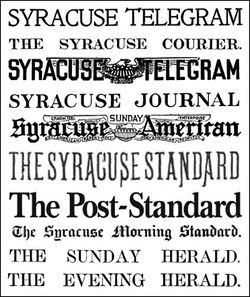
Syracuse has one major daily morning newspaper, The Post-Standard. Until 2001, Syracuse also had an evening paper, The Herald-Journal. Besides a Syracuse/Onondaga County edition, The Post-Standard publishes three additional editions: Cayuga, Madison, and Oswego for the other three counties of the metropolitan area, plus an additional edition on Sundays. It has six news bureaus throughout Central New York, as well as one in Albany (state capital) and Washington, DC.
Before the merger with the evening paper, The Post-Standard was named among the "10 best newspapers in America with a circulation of under 100,000" by Al Neuharth of USA Today (run by a competing organization). Since the merger, circulation has increased to over 120,000. Even outside of its four-county delivery area, the paper is available in many convenience stores and supermarkets from the Canadian to the Pennsylvanian border. The newspaper partly caters to this audience as well, covering many stories from the Ithaca, Utica, and Watertown areas. Since opening a new printing press in 2002, the paper calls itself "America's Most Colorful Newspaper," as almost every page contains color.
Syracuse New Times is a weekly, free, ad-supported arts and entertainment newspaper. Owned by Zimmer Ltd, Syracuse New Times is published in Syracuse, New York by Arthur Zimmer and distributed throughout the central New York region. The publication is released every Wednesday, with over 137,600 readers, and is distributed to over 950 locations in Central New York. Launched in 1969, it is one of the oldest alternative weekly newspapers in the country.
The Daily Orange, the newspaper of Syracuse University and SUNY ESF students, is read by over 20,000 people daily, and is widely distributed in the University Hill neighborhood and Armory Square. The Dolphin, the weekly student newspaper of Le Moyne College is also available, but read mainly by Le Moyne students.
There are other popular free newspapers, including Eagle Newspaper's downtown edition, the City Eagle, and Table Hopping, which focuses on the restaurant and entertainment scene.
Television
Syracuse has eight full-power broadcast television stations:
Additionally, networks such as Cornerstone Television channel 11 & 22, Univision, and MTV2 are broadcast by low-power television stations.[43]
Syracuse University's student-run TV station is CitrusTV. CitrusTV programming is broadcast on the university campus on the Orange Television Network. The station also provides content to Time Warner Cable Sports. Online, CitrusTV programs can be found on CitrusTV.net and The Post-Standard's Syracuse.com.
Syracuse's cable television provider is Time Warner Cable, which, as a part of its regular and digital offerings, provides a 24-hour local news channel (YNN), local sports channel, public access channel, and an additional PBS channel.
Dish Network and DirecTV also provide local satellite television subscribers with local broadcast stations.
Religion
Buddhism: Buddhism has its presence in Syracuse with the Zen Center of Syracuse on the Seneca Turnpike; as well as a center on Park Street, on the city's north side.
Christianity: Syracuse has two cathedrals, the Episcopal St. Paul's Cathedral and the Roman Catholic Cathedral of the Immaculate Conception. Both are located at Columbus Circle. Both are home to their respective dioceses, the Diocese of Central New York (Episcopal) and the Diocese of Syracuse (Roman Catholic). The Assembly of God,[ Southern Baptist Convention], and the United Church of Christ have their State offices in the Greater Syracuse area. Syracuse is also home to the novitiate center of the Jesuit New York Province, as well as the Basilica of the Sacred Heart of Jesus (Roman Catholic, with Mass offered in English and Polish). In addition there are dozens of churches in Syracuse of nearly every Christian denomination, including Jehovah's Witness, Christian Science, Reformed Presbyterian and Metaphysical Christian. Complete List
Hinduism: Hindu houses of worship include the Hindu Mandir of Central New York in Liverpool.
Sikhism: Sikh The house of worship is the Sikh Foundation of Syracuse, in Liverpool.
Islam: Islam also has a presence in Syracuse, with the Islamic Society of Central New York Mosque on Comstock Avenue and Muhammad's Study Group on West Kennedy Street.
Judaism: There are several Jewish synagogues in Syracuse, including Beth Shalom-Chevra Chas, Temple Adath Yeshurun and the Temple Society of Concord, which is considered to be the ninth oldest Jewish House of Worship in the United States.
Unitarian Universalism: There are two Unitarian Universalist Societies in Syracuse including May Memorial Unitarian Society and First Unitarian Universalist Society of Syracuse.
A complete list of Syracuse's Houses of Worship
Sports
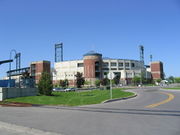
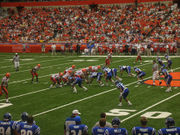
Current teams
| Sport | League | Club | Founded | Venue | League championships | Championship years |
|---|---|---|---|---|---|---|
| Baseball | IL | Syracuse Chiefs | 1935 | Alliance Bank Stadium | 8 | 1935, 1942, 1943, 1947, 1954, 1969, 1970, 1976 |
| Hockey | AHL | Syracuse Crunch | 1994 | War Memorial at Oncenter | 0 | N/A |
Professional
- Syracuse Chiefs (International League affiliate of the Washington Nationals) Stadium: Alliance Bank Stadium
- Syracuse Crunch (American Hockey League affiliate of the Columbus Blue Jackets) Arena: War Memorial at Oncenter
- Syracuse has a rugby club known as the [Syracuse Chargers]http://www.syracuserugby.com/
- The Syracuse ShockWave American Basketball Association (2000) has been announced to play in Syracuse beginning December 2010.
Syracuse was from 1946 until 1963 home to the NBA's Syracuse Nationals, which are now the Philadelphia 76ers. They played seventeen seasons in Syracuse and even won the NBA championship in 1955. The NBA's 24-second clock was invented in and first came into use in Syracuse. In March 2005 the city dedicated a monument to this fact. It is a 125% scaled model of the original shot clock used.
Syracuse has had several American Hockey League teams in the past, which traditionally did not last longer than three seasons. The Syracuse Blazers began play in the Eastern Hockey league in 1973. The league disbanded in 1973. The team then affiliated with the North America Hockey League. 1994 marked the introduction of a new team, the Syracuse Crunch, which have been playing at the War Memorial at Oncenter ever since.
Syracuse had a team in the National Lacrosse League(NLL) called the Syracuse Smash for three seasons from 1998 to 2000. They moved to Ottawa in 2001 and became the Ottawa Rebel
The Syracuse Spirit was a member of the American Lacrosse League, a short lived professional lacrosse league in 1988, based in Syracuse, New York. The Spirit played their home games at the Griffin Field in Liverpool, New York. The General Manager of the Spirit was Tom Scofield and the Head Coach was Jim Booth. The Spirit had a 4-1 record when the league folded.
The Syracuse Shock is a semi-professional American football team based in Syracuse, New York. They play in the Northeastern Football Alliance. The Syracuse Express were established in 1984 and were members of the Mid Continental Football League before that team contracted into the midwest. They joined the upstart New York Amateur Football League, where they became one of the league's premier teams, along with their rivals, the Buffalo Gladiators. After absorbing the Cortland Warriors in 1999 the team became the Central New York Express, although they still played their games in suburban Syracuse. The Express have won one NYAFL title in 2003. The NYAFL merged to become the Northeastern Football Alliance (NFA) and with the change, the team changed and was replaced by a new team named the Syracuse Shock.
Syracuse had a team for one season in the American Indoor Football League called the Syracuse Soldiers.
The Syracuse-based Monolith Athletic Club is working to return professional soccer to Syracuse. The Syracuse Salty Dogs existed for two seasons (2002–2004) until folding due to financial problems. The game attendance had been among the highest in the A-League.
Syracuse had a professional football team from 1890 to 1900 known as the Syracuse Athletic Association,[44] the independent All-Syracuse team which was known in 1921 as the Syracuse Pros in the APFA before leaving the league and reverting to the All-Syracuse team, and briefly in the 1936 American Football League season known as the Syracuse Braves.[45] In 1902, the first World Series of pro football was played at New York's original Madison Square Garden. The 5 teams in the tournament were the New York Knickerbockers, Syracuse AC, Warlow AC, the Orange (New Jersey) AC, and New York. Syracuse won the tournament 6-0 with Glen (Pop) Warner at guard.[46] The December 28, 1902 game where Syracuse defeated New York 5-0 at Madison Square Garden is credited as the first indoor pro football game.[47]
College
- Syracuse University Orange (Division I-A) Stadium: Carrier Dome
- Le Moyne College Dolphins (Division II)
- Onondaga Community College Lazers (NJCAA)
- State University of New York College of Environmental Science and Forestry
Syracuse University sports are by far the most attended sporting events in the Syracuse area. Basketball games often draw over 30,000 fans, and football games over 40,000. The university has bred dozens of famous professional players since starting an athletics program in the late nineteenth century, including all-time greats Jim Brown, Larry Csonka and Dave Bing, and present professional stars Marvin Harrison, Carmelo Anthony, Dwight Freeney, Jason Hart, and Donovan McNabb. Both teams play in the Carrier Dome.
Famous Syracusans
Syracuse has been the residence of several celebrities,[48] among them:
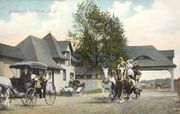
- Dylan Baker - actor.
- David Foster Wallace - author.
- Ra Ra Riot - Indie rock n' roll band.
- Mark Levinson - Producer of "Mystic Pizza" and "Home Alone".
- Kim Black - Olympic Gold Medal Swimmer
- Rory Cochrane - actor
- Mark Copani- wrestler under the name Muhammad Hassan
- Tom Cruise - actor
- Earth Crisis - part of the straight edge hardcore music movement.
- Robert F. Engle - economist
- Thom Filicia - interior design expert for American TV show Queer Eye for the Straight Guy
- Richard Gere - actor
- J.Son Dinant - comedian, actor, reality TV personality
- Bobcat Goldthwait - comedian
- Grace Jones - model, singer, actress
- Edna May - singer, actress
- Mikey Welsh - former bass player of Weezer
- Tom Kenny - comedian, actor (best known as the voice of SpongeBob SquarePants)
- Siobhan Fallon Hogan - actress
- Terry McAuliffe - former chairman of the Democratic National Committee and confidant of President Bill Clinton
- Rod Serling - Screenwriter
- Honor Bright - Pop Punk Band
- Polar Bear Club - pop-punk/melodic hardcore band
- The Schubert brothers - Broadway entrepreneurs
- Craig Shirley - author and political consultant
- Gustav Stickley - furniture maker and American Craftsman spokesperson
- Jimmy Van Heusen - songwriter
- Tim Connolly - Buffalo Sabres ice hockey player
- Jay Leach - New Jersey Devils ice hockey player
- Andray Blatche- Washington Wizards basketball player
- Dorsey Levens - NFL player for the Green Bay Packers, Philadelphia Eagles, and the New York Giants
- Frank DiPino - MLB player for the Milwaukee Brewers, Houston Astros, Chicago Cubs, St. Louis Cardinals, and the Kansas City Royals
- Danny Schayes - NBA player for the Utah Jazz, Denver Nuggets, Milwaukee Bucks, Los Angeles Lakers, Phoenix Suns, Miami Heat, and the Orlando Magic
- Dolph Schayes
- David Muir - ABC News Anchor
- Carmelo Anthony - player for Denver Nuggets - Went to Syracuse University for 1 year, but is from Brooklyn, New York
- Vice President Joe Biden - Went to Syracuse University, but is from Scranton, Pennsylvania
Several other well-known individuals have ties to the Syracuse metropolitan area, including:
- Joey Belladonna-singer of heavy metal band Anthrax; born Joseph Belardini in Oswego, New York
- L. Frank Baum - author of The Wonderful Wizard of Oz; born in Chittenango, New York
- Grover Cleveland - two-term United States President; childhood resident of Fayetteville, New York
- Jonathan Murray - American television producer, born in Fayetteville, New York
- Gym Class Heroes - band from Geneva, New York
- Beezie Madden - Olympic Gold Medal Equestrian Show Jumper, resident of Cazenovia, New York
- Leland Stanford - founder of Stanford University; graduate of Cazenovia Seminary
- Eliza Orlins, contestant on Survivor: Vanuatu, and Survivor: Micronesia
- Dave Mirra - Professional BMX bike rider, former resident of Chittenango, New York
- Robin Curtis - Actress of Star Trek films, resident of Cazenovia, New York
- Mark Callahan - Brown University Center, First Team All Ivy League, First Team ECAC, Academic All Ivy
Syracuse in film and television
Andy davoli (the sopranos)
Events
Sister cities
Syracuse's sister cities are:
Syracuse suburbs
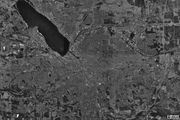
Towns and villages in Onondaga County make up most of the suburban communities in the Greater Syracuse area. Towns and villages in such surrounding counties as Oswego, Madison, Cortland, or Cayuga on the border of Onondaga County may also be considered Syracuse suburbs.
|
|
References
- ↑ "Find a County". National Association of Counties. http://www.naco.org/Template.cfm?Section=Find_a_County&Template=/cffiles/counties/usamap.cfm. Retrieved 2008-01-31.
- ↑ http://www.census.gov/popest/cities/tables/SUB-EST2008-01.csv
- ↑ "America's Best Places to Raise a Family". Forbes.com. http://www.forbes.com/2010/06/04/best-places-family-lifestyle-real-estate-cities-kids.html.
- ↑ "Revolutionary War veteran's son gave city its name". The Post-Standard (Syracuse, New York). August 27, 2002.
- ↑ "Our Founders" (PDF). City of Syracuse. 2004. http://www.syracuse.ny.us/Pdfs/Renewing%20Syracuse/Summer%202004/Issue%207%20Page%207.pdf.
- ↑ http://www.tribunes.com/tribune/sel/bell.htm
- ↑ 7.0 7.1 http://ny.water.usgs.gov/pubs/fs/fs13900/FS139-00.pdf
- ↑ Encyclopedia AMERICANA,vol.26,1968
- ↑ "Industrial Age Fed Syracuse Boom". Syracuse Then and Now, 2010. http://syracusethenandnow.org/History/IndustrialAgeFedSyracuseBoom.htm. Retrieved 2010-07-29.
- ↑ "1932-1934 Franklin V-12". HowStuffWorks, Inc., 2008-2010. http://auto.howstuffworks.com/1932-1934-Franklin-v122.htm. Retrieved 2010-07-17.
- ↑ 11.0 11.1 The Jerry Rescue - New York History Net
- ↑ "US Gazetteer files: 2000 and 1990". United States Census Bureau. 2005-05-03. http://www.census.gov/geo/www/gazetteer/gazette.html. Retrieved 2008-01-31.
- ↑ Weiner, Mark: "Census of trees sees healthy population - Syracuse, one of Upstate's leafiest cities, is coming back after the devastating 1998 Labor Day Storm", The Post-Standard, 27 April 2001
- ↑ http://en.wikipedia.org/wiki/Onondaga_Lake
- ↑ City of Syracuse - Executive Summary (2003)
- ↑ "Snowfall - Average Total In Inches", NOAA, 23 June 2004
- ↑ Cappella, Chris: "Answers: 10 snowiest 'cities' aren't all in New York", USA Today, 3 October 2003
- ↑ Kirst, Sean: "We won't buckle under the Snowbelt's blows", The Post-Standard, 14 March 2005
- ↑ Staff Reports: "A Storm for the records - Blizzard of 1993 brought 42.9 inches", The Post-Standard, 31 December 2003
- ↑ McKelvey, Blake (1995). Snow in the Cities: A History of America's Urban Response. Rochester, New York: University of Rochester Press. p. 133. ISBN 9781878822543. http://books.google.com/books?id=Xx9CZkssBfIC&lpg=PA133&ots=4QjLHxZLub&dq=february%201958%20snow%20syracuse&pg=PA133#v=onepage&q=february%201958%20snow%20syracuse&f=false. Retrieved 2010-08-15.
- ↑ 21.0 21.1 "NCDC: U.S. Climate Normals". National Oceanic and Atmospheric Administration. http://cdo.ncdc.noaa.gov/climatenormals/clim20/ny/308383.pdf. Retrieved 2010-05-14.
- ↑ Weiner, Mark: "Season soars into record - Warmest summer may affect our winter", The Post-Standard, 22 September 2005
- ↑ "Climatological Normals of Syracuse". Hong Kong Observatory. http://www.hko.gov.hk/wxinfo/climat/world/eng/n_america/us/syracuse_e.htm. Retrieved 2010-05-14.
- ↑ Gibson, Campbell (June 1998). "Population of the 100 Largest Cities and Other Urban Places in the United States: 1790 to 1990". United States Census Bureau, Population Division. Detailed Tables 8—21. Archived from the original on 2010-08-15. http://www.webcitation.org/5s18ODkbi. Retrieved 2010-08-15.
- ↑ "Syracuse city, New York - Population Finder". United States Census Bureau. Archived from the original on 2010-08-15. http://www.webcitation.org/5s19VUCzw. Retrieved 2010-08-15.
- ↑ "American FactFinder". United States Census Bureau. http://factfinder.census.gov. Retrieved 2008-01-31.
- ↑ http://www.city-data.com/city/Syracuse-New-York.html
- ↑ Greater Syracuse Economic Council
- ↑ Bristol-Myers Squibb's Syracuse Campus
- ↑ Time Warner Cable's Syracuse Division
- ↑ Moriarty, Rick: "CNY Leads in Job Growth", The Post-Standard, 21 April 2006
- ↑ http://www.syracusecityschools.com/
- ↑ Syracuse University Facts.
- ↑ [1].
- ↑ http://www.onlib.org/
- ↑ City of Syracuse Department of Parks
- ↑ Moriarty, Rick (2006-09-26). "High flying idea stuck". The Post-Standard.
- ↑ "Graphic of commuter traffic volume". Syracuse Central. http://www.syracusecentral.com/images/market_data/cnycommute_lg.jpg.
- ↑ http://www.syracuse.com/news/index.ssf/2009/11/post_77.html
- ↑ http://opinionator.blogs.nytimes.com/2010/08/10/rebirth-of-a-city/?ref=opinion
- ↑ "City of Syracuse". http://www.syracuse.ny.us/Mayors_Biography.aspx. Retrieved 2009-11-04.
- ↑ "Mayors Against Illegal Guns: Coalition Members". http://www.mayorsagainstillegalguns.org/html/about/members.shtml.
- ↑ CNY Media: Syracuse TV Stations Transmitters
- ↑ http://www.wnypfra.org/index.htm
- ↑ http://www.billsbackers.com/1936.htm
- ↑ http://www.profootballhof.com/history/general/chronology/1869-1939.jsp
- ↑ http://www.profootballhof.com/history/story.jsp?story_id=1476
- ↑ The previous list of Syracusans was filtered to only include those with over a million Google hits for their name plus their profession.
- ↑ "Mayoral Proclamation regarding sister City" (PDF). October 2001. http://www.syracuse.ny.us/mayorDocs/2/Taiwan.pdf. at Syracuse, Mayor Proclamations
External links
- City of Syracuse, New York
- Onondaga County Historical Association Museum & Research Center
- Syracuse Central
- Syracuse at the Open Directory Project
- Syracuse.com - News site affiliated with The Post-Standard
- Syracuse Arts
- Syracuse Then And Now (Historical Site)
- Buildings of Syracuse
- Collection of Central NY photos from davidmetraux.com
- German Immigrant Ancestors in Syracuse and Onondaga County, New York (Historical)
- Syracuse City Court information
- Syracuse history/genealogy
- Syracuse Wiki - Community Edited Area Resource
- Syracuse (New York) travel guide from Wikitravel
|
|||||||||||||||||||||||||||||
|
|||||||||||||||||
